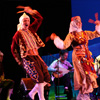
Turkey has a very ancient folk dance tradition, which varies from region to region, each dance being colourful, rhythmic, elegant and stylish. The following are among the most popular: “Çayda Çıra” from the Sivas region in Central Anatolia is performed by young girls dressed in silver and gold embroidered kaftans who dance in the dark with lighted candles in their hands. In the “Silifke Yoğurdu” from the Mersin region in the South Mediterranean, dancers click wooden spoons together above their heads. “Şeyh Şamil" from the Kars region in the East, is a beautifully dramatised legend of a Caucasian hero. "Kılıç Kalkan” is an epic dance performed with swords and shields from the region of Bursa, and “Zeybek” from Izmir is another epic and vigorous folk dance performed, by male dancers who bang their knees on the floor in between steps.
Folklore has also had a considerable influence on ballet. First imported from Europe and Russia, ballet became institutionalised in the Republican era along with other performing arts. The Turkish State Ballet owes its momentum and development to the great British choreographer Dame Ninette de Valois. The State Ballet in both Ankara and İstanbul has, for decades, performed many world classics. Several new foreign and Turkish productions have been introduced into the repertoire over the years and a number of modern dance groups like the infamous “Fire of Anatolia” (Anadolu Atesi) have recently begun to give performances all over the world.
 Turkey has a very ancient folk dance tradition, which varies from region to region, each dance being colourful, rhythmic, elegant and stylish. The following are among the most popular: “Çayda Çıra” from the Sivas region in Central Anatolia is performed by young girls dressed in silver and gold embroidered kaftans who dance in the dark with lighted candles in their hands. In the “Silifke Yoğurdu” from the Mersin region in the South Mediterranean, dancers click wooden spoons together above their heads. “Şeyh Şamil" from the Kars region in the East, is a beautifully dramatised legend of a Caucasian hero. "Kılıç Kalkan” is an epic dance performed with swords and shields from the region of Bursa, and “Zeybek” from Izmir is another epic and vigorous folk dance performed, by male dancers who bang their knees on the floor in between steps.
Turkey has a very ancient folk dance tradition, which varies from region to region, each dance being colourful, rhythmic, elegant and stylish. The following are among the most popular: “Çayda Çıra” from the Sivas region in Central Anatolia is performed by young girls dressed in silver and gold embroidered kaftans who dance in the dark with lighted candles in their hands. In the “Silifke Yoğurdu” from the Mersin region in the South Mediterranean, dancers click wooden spoons together above their heads. “Şeyh Şamil" from the Kars region in the East, is a beautifully dramatised legend of a Caucasian hero. "Kılıç Kalkan” is an epic dance performed with swords and shields from the region of Bursa, and “Zeybek” from Izmir is another epic and vigorous folk dance performed, by male dancers who bang their knees on the floor in between steps.